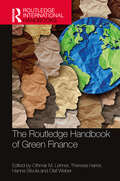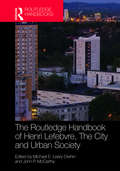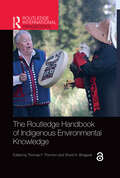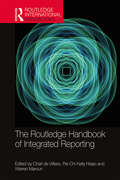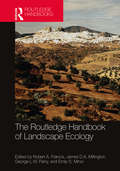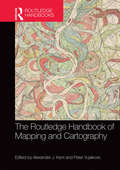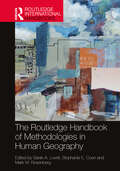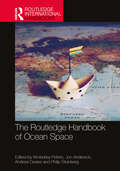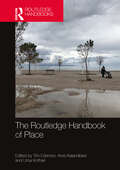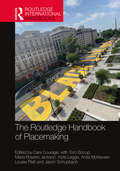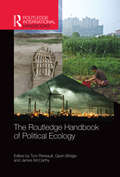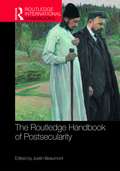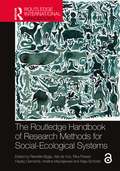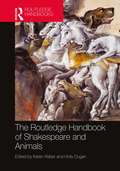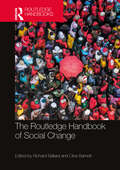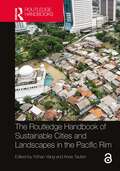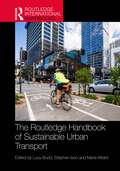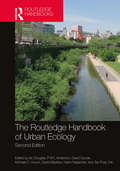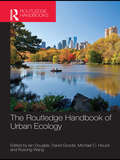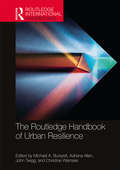- Table View
- List View
The Routledge Handbook of Green Finance (Routledge International Handbooks)
by Othmar M. Lehner, Theresia Harrer, Hanna Silvola and Olaf WeberGreen finance is heralded in theory and practice as the new panacea – the ideal way to support the green transition of businesses into more sustainable, environmentally responsible forms, by means of incentivized financial investments. This handbook brings together a variety of expert scholars with industry specialists to offer the most authoritative overview of green finance to date, presenting the current situation in the field. It focuses on green finance in a comprehensive way, discussing its characteristics, underlying principles, and mechanisms. The book carefully illuminates the issues surrounding green finance and delineates its boundaries, mapping out and displaying the disparate voices, traditions, and professional communities engaged in green and sustainable finance activities. Specifically, it examines the "environmental" in the environmental, social, and governance (ESG) measurements, while also discussing the interplay between each measurement. It develops a range of analytic approaches to the subject, both appreciative and critical, and synthesizes new theoretical constructs that make better sense of hybrid financial relationships. Furthermore, the handbook illustrates existing best practices and theories, and critically examines the gaps to derive the necessary future research questions. It highlights the essential issues and debates and provides a robust research agenda. As such, it helps to create an effective market for the various green financing instruments through clarification and standardization. This handbook will be the standard reference work for a broad audience, encompassing scholars, researchers, and students but also interested professionals, regulators, and policymakers wishing to orient themselves in a rapidly developing and increasingly topical field.
The Routledge Handbook of Henri Lefebvre, The City and Urban Society
by Michael E. Leary-Owhin John P. McCarthyThe Routledge Handbook of Henri Lefebvre,The City and Urban Society is the first edited book to focus on Lefebvre's urban theories and ideas from a global perspective, making use of recent theoretical and empirical developments, with contributions from eminent as well as emergent global scholars. The book provides international comparison of Lefebvrian research and theoretical conjecture and aims; to engage with and critique Lefebvre's ideas in the context of contemporary urban, social and environmental upheavals; to use Lefebvre's spatial triad as a research tool as well as a point of departure for the adoption of ideas such as differential space; to reassess Lefebvre's ideas in relation to nature and global environmental sustainability; and to highlight how a Lefebvrian approach might assist in mobilising resistance to the excesses of globalised neoliberal urbanism. The volume draws inspiration from Lefebvre's key texts (The Production of Space; Critique of Everyday Life; and The Urban Revolution) and includes a comprehensive introduction and concluding chapter by the editors. The conclusions highlight implications in relation to increasing spatial inequalities; increasing diversity of needs including those of migrants; more authoritarian approaches; and asymmetries of access to urban space. Above all, the book illustrates the continuing relevance of Levebvre's ideas for contemporary urban issues and shows – via global case studies – how resistance to spatial domination by powerful interests might be achieved. The Handbook helps the reader navigate the complex terrain of spatial research inspired by Lefebvre. In particular the Handbook focuses on: the series of struggles globally for the 'right to the city' and the collision of debates around the urban age, 'cityism' and planetary urbanisation. It will be a guide for graduate and advanced undergraduate teaching, and a key reference for academics in the fields of Human Geography, Sociology, Political Science, Applied Philosophy, Planning, Urban Theory and Urban Studies. Practitioners and activists in the field will also find the book of relevance.
The Routledge Handbook of Indigenous Development (Routledge International Handbooks)
by Nancy Postero John-Andrew McNeish Katharina Ruckstuhl Irma A. Velásquez NimatujThis Handbook inverts the lens on development, asking what Indigenous communities across the globe hope and build for themselves. In contrast to earlier writing on development, this volume focuses on Indigenous peoples as inspiring theorists and potent political actors who resist the ongoing destruction of their livelihoods. To foster their own visions of development, they look from the present back to Indigenous pasts and forward to Indigenous futures. Key questions: How do Indigenous theories of justice, sovereignty, and relations between humans and non-humans inform their understandings of development? How have Indigenous people used Rights of Nature, legal pluralism, and global governance systems to push for their visions? How do Indigenous relations with the Earth inform their struggles against natural resource extraction? How have native peoples negotiated the dangers and benefits of capitalism to foster their own life projects? How do Indigenous peoples in diaspora and in cities around the world contribute to Indigenous futures? How can Indigenous intellectuals, artists, and scientists control their intellectual property and knowledge systems and bring into being meaningful collective life projects? The book is intended for Indigenous and non-Indigenous activists, communities, scholars, and students. It provides a guide to current thinking across the disciplines that converge in the study of development, including geography, anthropology, environmental studies, development studies, political science, and Indigenous studies.
The Routledge Handbook of Indigenous Environmental Knowledge (Routledge International Handbooks)
by Thomas F. Thornton Shonil A. BhagwatThis volume provides an overview of key themes in Indigenous Environmental Knowledge (IEK) and anchors them with brief but well-grounded empirical case studies of relevance for each of these themes, drawn from bioculturally diverse areas around the world. It provides an incisive, cutting-edge overview of the conceptual and philosophical issues, while providing constructive examples of how IEK studies have been implemented to beneficial effect in ecological restoration, stewardship, and governance schemes. Collectively, the chapters in the Routledge Handbook of Indigenous Environmental Knowledge cover Indigenous Knowledge not only in a wide range of cultures and livelihood contexts, but also in a wide range of environments, including drylands, savannah grassland, tropical forests, mountain landscapes, temperate and boreal forests, Pacific and Indian Ocean islands, and coastal environments. The chapters discuss the complexities and nuances of Indigenous cosmologies and ethno-metaphysics and the treatment and incorporation of IEK in local, national, and international environmental policies. Taken together, the chapters in this volume make a strong case for the potential of Indigenous Knowledge in addressing today’s local and global environmental challenges, especially when approached from a perspective of appreciative inquiry, using cross-cultural methods and ethical, collaborative approaches which limit bias and inappropriate extraction of IEK. The book is a guide for graduate and advanced undergraduate teaching, and a key reference for academics in development studies, environmental studies, geography, anthropology, and beyond, as well as anyone with an interest in Indigenous Environmental Knowledge.
The Routledge Handbook of Integrated Reporting (Routledge International Handbooks)
by Charl De VilliersThis timely handbook provides a current and comprehensive examination of integrated reporting, both practical and research-based. It offers insights and different perspectives from more than 60 authors, including representatives of the International Integrated Reporting Council, Integrated Reporting Committee of South Africa, professional bodies and audit firms, as well as leading academics in the fields of integrated reporting, sustainability reporting and corporate social responsibility. This collected work provides an in-depth review of the development of integrated reporting, with a focus on the interpretation and guidance provided by the International Integrated Reporting Council. It encourages the development of new thinking and research topics in the area of integrated reporting (such as links between integrated reporting and reports focused on financial and corporate social responsibility matters), as well as showcasing how integrated reporting issues are seen and practiced in different parts of the world. The chapters include reviews of the most recent research, practitioner viewpoints, conceptual pieces, case studies and disclosure analyses. Accessible and engaging, this handbook will be an invaluable overview for those new to the field or those who are interested in ensuring they are up to date with its developments, as well as those who are concerned with how to construct an integrated report.
The Routledge Handbook of International Environmental Policy
by Mahua BasuThis handbook is a one-stop, comprehensive guide to global initiatives for climate action. It examines policies to tackle climate change and the critical role various organizations play.The volume: Includes in-depth discussion of individual issues related to the environment Highlights global initiatives, negotiations, and international organizations responsible for climate action, protecting marine and freshwater environment, protecting atmosphere and climate, conserving biological diversity, chemicals and wastes management, environmental governance, safeguarding against warfare and disasters Debates on-ground implications of the international policies for the Global South Brings together case studies from across the world Presents a toolkit for environment practitioners to seek sustainable and practicable solutions to problems Includes suggested readings for researchers Brings together primary documents, supportive illustrations, graphs, and maps The handbook will be an essential reference for scholars and researchers of environmental studies, environmental policy and governance, sustainability and resilience. It will also be indispensable for policy makers, think tanks and NGOs.
The Routledge Handbook of Landscape Ecology
by Robert A. Francis, James D.A. Millington, George L.W. Perry, and Emily S. MinorThe Handbook provides a supporting guide to key aspects and applications of landscape ecology to underpin its research and teaching. A wide range of contributions written by expert researchers in the field summarize the latest knowledge on landscape ecology theory and concepts, landscape processes, methods and tools, and emerging frontiers. Landscape ecology is an interdisciplinary and holistic discipline, and this is reflected in the chapters contained in this Handbook. Authors from varying disciplinary backgrounds tackle key concepts such as landscape structure and function, scale and connectivity; landscape processes such as disturbance, flows, and fragmentation; methods such as remote sensing and mapping, fieldwork, pattern analysis, modelling, and participation and engagement in landscape planning; and emerging frontiers such as ecosystem services, landscape approaches to biodiversity conservation, and climate change. Each chapter provides a blend of the latest scientific understanding of its focal topics along with considerations and examples of their application from around the world. An invaluable guide to the concepts, methods, and applications of landscape ecology, this book will be an important reference text for a wide range of students and academics in ecology, geography, biology, and interdisciplinary environmental studies.
The Routledge Handbook of Latin American Development (Routledge International Handbooks)
by Julie Cupples Marcela Palomino-Schalscha Manuel PrietoThe Routledge Handbook of Latin American Development seeks to engage with comprehensive, contemporary, and critical theoretical debates on Latin American development. The volume draws on contributions from across the humanities and social sciences and, unlike earlier volumes of this kind, explicitly highlights the disruptions to the field being brought by a range of anti-capitalist, decolonial, feminist, and ontological intellectual contributions. The chapters consider in depth the harms and suffering caused by various oppressive forces, as well as the creative and often revolutionary ways in which ordinary Latin Americans resist, fight back, and work to construct development defined broadly as the struggle for a better and more dignified life. The book covers many key themes including development policy and practice; neoliberalism and its aftermath; the role played by social movements in cities and rural areas; the politics of water, oil, and other environmental resources; indigenous and Afro-descendant rights; and the struggles for gender equality. With contributions from authors working in Latin America, the US and Canada, Europe, and New Zealand at a range of universities and other organizations, the handbook is an invaluable resource for students and teachers in development studies, Latin American studies, cultural studies, human geography, anthropology, sociology, political science, and economics, as well as for activists and development practitioners.
The Routledge Handbook of Mapping and Cartography
by Alexander J. Kent Peter VujakovicThis new Handbook unites cartographic theory and praxis with the principles of cartographic design and their application. It offers a critical appraisal of the current state of the art, science, and technology of map-making in a convenient and well-illustrated guide that will appeal to an international and multi-disciplinary audience. No single-volume work in the field is comparable in terms of its accessibility, currency, and scope. The Routledge Handbook of Mapping and Cartography draws on the wealth of new scholarship and practice in this emerging field, from the latest conceptual developments in mapping and advances in map-making technology to reflections on the role of maps in society. It brings together 43 engaging chapters on a diverse range of topics, including the history of cartography, map use and user issues, cartographic design, remote sensing, volunteered geographic information (VGI), and map art. The title’s expert contributions are drawn from an international base of influential academics and leading practitioners, with a view to informing theoretical development and best practice. This new volume will provide the reader with an exceptionally wide-ranging introduction to mapping and cartography and aim to inspire further engagement within this dynamic and exciting field. The Routledge Handbook of Mapping and Cartography offers a unique reference point that will be of great interest and practical use to all map-makers and students of geographic information science, geography, cultural studies, and a range of related disciplines.
The Routledge Handbook of Memory and Place
by Steven High Sarah De Nardi Hilary Orange Eerika Koskinen-KoivistoThis Handbook explores the latest cross-disciplinary research on the inter-relationship between memory studies, place, and identity. In the works of dynamic memory, there is room for multiple stories, versions of the past and place understandings, and often resistance to mainstream narratives. Places may live on long after their physical destruction. This collection provides insights into the significant and diverse role memory plays in our understanding of the world around us, in a variety of spaces and temporalities, and through a variety of disciplinary and professional lenses. Many of the chapters in this Handbook explore place-making, its significance in everyday lives, and its loss. Processes of displacement, where people’s place attachments are violently torn asunder, are also considered. Ranging from oral history to forensic anthropology, from folklore studies to cultural geographies and beyond, the chapters in this Handbook reveal multiple and often unexpected facets of the fascinating relationship between place and memory, from the individual to the collective. This is a multi- and intra-disciplinary collection of the latest, most influential approaches to the interwoven and dynamic issues of place and memory. It will be of great use to researchers and academics working across Geography, Tourism, Heritage, Anthropology, Memory Studies, and Archaeology.
The Routledge Handbook of Methodologies in Human Geography (Routledge International Handbooks)
by Sarah A. Lovell Stephanie E. Coen Mark W. RosenbergThe Routledge Handbook of Methodologies in Human Geography is the defining reference for academics and postgraduate students seeking an advanced understanding of the debates, methodological developments and methods transforming research in human geography. Divided into three sections, Part I reviews how the methods of contemporary human geography reflect the changing intellectual history of human geography and events both within human geography and society in general. In Part II, authors critically appraise key methodological and theoretical challenges and opportunities that are shaping contemporary research in various parts of human geography. Contemporary directions within the discipline are elaborated on by established and emerging researchers who are leading ontological debates and the adoption of innovative methods in geographic research. In Part III, authors explore cross-cutting methodological challenges and prompt questions about the values and goals underpinning geographical research work, such as: Who are we engaging in our research? Who is our research ‘for’? What are our relationships with communities? Contributors emphasize examples from their research and the research of others to reflect the fluid, emotional and pragmatic realities of research. This handbook captures key methodological developments and disciplinary influences emerging from the various sub-disciplines of human geography.
The Routledge Handbook of Ocean Space (Routledge International Handbooks)
by Kimberley PetersInvisible as the seas and oceans may be for so many of us, life as we know it is almost always connected to, and constituted by, activities and occurrences that take place in, on and under our oceans. The Routledge Handbook of Ocean Space provides a first port of call for scholars engaging in the ‘oceanic turn’ in the social sciences, offering a comprehensive summary of existing trends in making sense of our water worlds, alongside new, agenda-setting insights into the relationships between society and the ‘seas around us’. Accordingly, this ambitious text not only attends to a growing interest in our oceans, past and present; it is also situated in a broader spatial turn across the social sciences that seeks to account for how space and place are imbricated in socio-cultural and political life. Through six clearly structured and wide-ranging sections, The Routledge Handbook of Ocean Space examines and interrogates how the oceans are environmental, historical, social, cultural, political, legal and economic spaces, and also zones where national and international security comes into question. With a foreword and introduction authored by some of the leading scholars researching and writing about ocean spaces, alongside 31 further, carefully crafted chapters from established as well as early career academics, this book provides both an accessible guide to the subject and a cutting-edge collection of critical ideas and questions shaping the social sciences today. This handbook brings together the key debates defining the ‘field’ in one volume, appealing to a wide, cross-disciplinary social science and humanities audience. Moreover, drawing on a range of international examples, from a global collective of authors, this book promises to be the benchmark publication for those interested in ocean spaces, past and present. Indeed, as the seas and oceans continue to capture world-wide attention, and the social sciences continue their seaward ‘turn’, The Routledge Handbook of Ocean Space will provide an invaluable resource that reveals how our world is a water world.
The Routledge Handbook of Place
by Tim EdensorThe handbook presents a compendium of the diverse and growing approaches to place from leading authors as well as less widely known scholars, providing a comprehensive yet cutting-edge overview of theories, concepts and creative engagements with place that resonate with contemporary concerns and debates. The volume moves away from purely western-based conceptions and discussions about place to include perspectives from across the world. It includes an introductory chapter, which outlines key definitions, draws out influential historical and contemporary approaches to the theorisation of place and sketches out the structure of the book, explaining the logic of the seven clearly themed sections. Each section begins with a short introductory essay that provides identifying key ideas and contextualises the essays that follow. The original and distinctive contributions from both new and leading authorities from across the discipline provide a wide, rich and comprehensive collection that chimes with current critical thinking in geography. The book captures the dynamism and multiplicity of current geographical thinking about place by including both state-of-the-art, in-depth, critical overviews of theoretical approaches to place and new explorations and cases that chart a framework for future research. It charts the multiple ways in which place might be conceived, situated and practised. This unique, comprehensive and rich collection will be an essential resource for undergraduate and graduate teaching, for experienced academics across a wide range of disciplines and for policymakers and place-marketers. It will provide an invaluable and up-to-date guide to current thinking across the range of disciplines, such as Geography, Sociology and Politics, and interdisciplinary fields such as Urban Studies, Environmental Studies and Planning.
The Routledge Handbook of Placemaking (Routledge International Handbooks)
by Cara CourageThis Handbook is the first to explore the emergent field of ‘placemaking’ in terms of the recent research, teaching and learning, and practice agenda for the next few years. Offering valuable theoretical and practical insights from the leading scholars and practitioners in the field, it provides cutting-edge interdisciplinary research on the placemaking sector. Placemaking has seen a paradigmatic shift in urban design, planning, and policy to engage the community voice. This Handbook examines the development of placemaking, its emerging theories, and its future directions. The book is structured in seven distinct sections curated by experts in the areas concerned. Section One provides a glimpse at the history and key theories of placemaking and its interpretations by different community sectors. Section Two studies the transformative potential of placemaking practice through case studies on different places, methodologies, and theoretical frameworks. It also reveals placemaking’s potential to nurture a holistic community engagement, social justice, and human-centric urban environments. Section Three looks at the politics of placemaking to consider who is included and who is excluded from its practice and if the concept of placemaking needs to be reconstructed. Section Four deals with the scales and scopes of art-based placemaking, moving from the city to the neighborhood and further to the individual practice. It juxtaposes the voice of the practitioner and professional alongside that of the researcher and academic. Section Five tackles the socio-economic and environmental placemaking issues deemed pertinent to emerge more sustainable placemaking practices. Section Six emphasizes placemaking’s intersection with urban design and planning sectors and incudes case studies of generative planning practice. The final seventh section draws on the expertise of placemakers, researchers, and evaluators to present the key questions today, new methods and approaches to evaluation of placemaking in related fields, and notions for the future of evaluation practices. Each section opens with an introduction to help the reader navigate the text. This organization of the book considers the sectors that operate alongside the core placemaking practice. This seminal Handbook offers a timely contribution and international perspectives for the growing field of placemaking. It will be of interest to academics and students of placemaking, urban design, urban planning and policy, architecture, geography, cultural studies, and the arts.
The Routledge Handbook of Political Ecology (Routledge International Handbooks)
by Gavin Bridge Tom Perreault James McCarthyThe Routledge Handbook of Political Ecology presents a comprehensive and authoritative examination of the rapidly growing field of political ecology. Located at the intersection of geography, anthropology, sociology, and environmental history, political ecology is one of the most vibrant and conceptually diverse fields of inquiry into nature-society relations within the social sciences. The Handbook serves as an essential guide to this rapidly evolving intellectual landscape. With contributions from over 50 leading authors, the Handbook presents a systematic overview of political ecology’s origins, practices and core concerns, and aims to advance both ongoing and emerging debates. While there are numerous edited volumes, textbooks, and monographs under the heading ‘political ecology,’ these have tended to be relatively narrow in scope, either as collections of empirically based (mostly case study) research on a given theme, or broad overviews of the field aimed at undergraduate audiences. The Routledge Handbook of Political Ecology is the first systematic, comprehensive overview of the field. With authors from North and South America, Europe, Australia and elsewhere, the Handbook of Political Ecology provides a state of the art examination of political ecology; addresses ongoing and emerging debates in this rapidly evolving field; and charts new agendas for research, policy, and activism. The Routledge Handbook of Political Ecology introduces political ecology as an interdisciplinary academic field. By presenting a ‘state of the art’ examination of the field, it will serve as an invaluable resource for students and scholars. It not only critically reviews the key debates in the field, but develops them. The Handbook will serve as an excellent resource for graduate and advanced undergraduate teaching, and is a key reference text for geographers, anthropologists, sociologists, environmental historians, and others working in and around political ecology.
The Routledge Handbook of Postsecularity (Routledge International Handbooks)
by Justin BeaumontThe Routledge Handbook of Postsecularity offers an internationally significant and comprehensive interdisciplinary collection which provides a series of critical reviews of the current state of the art and future trends in philosophical, theoretical, and conceptual terms. The volume likewise presents a range of empirical knowledges and engagements with postsecularity. A critical yet sympathetic dialogue across disciplinary divides in an international context ensures that the volume covers a wide and interrelated intellectual and geographical scope. The editor’s introduction with Klaus Eder offers a robust foundation for the volume, setting out the central aims and objectives, the rationale for the contributions, and an outline of the structure. Thorny issues of normativity and empirical challenges are highlighted for the reader. The handbook comprises four interrelated sections. Part I: Philosophical meditations discusses postsecularity from philosophical standpoints, and Part II: Theological perspectives presents contributions from a variety of theological viewpoints. Part III: Theory, space, social relations contains pieces from geography, planning, sociology, and religious studies that delve into theoretically informed empirical implications of postsecularity. Part IV: Political and social engagement offers chapters that emphasize the political and social implications of the debate. In the Afterword, Eduardo Mendieta joins the editor to reflect on the notion of reflexive secularization across the volume as a whole, alluding to new lines of inquiry. The handbook is an invaluable guide for graduate and advanced undergraduate teaching, and a key reference for students and scholars of human geography, sociology, political science, applied philosophy, urban and public theology, planning, and urban studies.
The Routledge Handbook of Religions and Global Development (Routledge International Handbooks)
by Emma TomalinThis Handbook provides a cutting-edge survey of the state of research on religions and global development. Part one highlights critical debates that have emerged within research on religions and development, particularly with respect to theoretical, conceptual and methodological considerations, from the perspective of development studies and its associated disciplines. Parts two to six look at different regional and national development contexts and the place of religion within these. These parts integrate and examine the critical debates raised in part one within empirical case studies from a range of religions and regions. Different religions are situated within actual locations and case studies thus allowing a detailed and contextual understanding of their relationships to development to emerge. Part seven examines the links between some important areas within development policy and practice where religion is now being considered, including: Faith-Based Organisations and Development Public Health, Religion and Development Human rights, Religion and Development Sustainable Development, Climate Change and Religion Global Institutions and Religious Engagement in Development Economic Development and Religion Religion, Development and Fragile States Development and Faith-Based Education Taking a global approach, the Handbook covers Africa, Latin America, South Asia, East and South-East Asia, and the Middle East. It is essential reading for students and researchers in development studies and religious studies, and is highly relevant to those working in area studies, as well as a range of disciplines, from theology, anthropology and economics to geography, international relations, politics and sociology.
The Routledge Handbook of Research Methods for Social-Ecological Systems (Routledge International Handbooks)
by Rika Preiser Reinette Biggs Maja Schlüter Alta De Vos Hayley Clements Kristine MaciejewskiThe Routledge Handbook of Research Methods for Social-Ecological Systems provides a synthetic guide to the range of methods that can be employed in social-ecological systems (SES) research. The book is primarily targeted at graduate students, lecturers and researchers working on SES, and has been written in a style that is accessible to readers entering the field from a variety of different disciplinary backgrounds. Each chapter discusses the types of SES questions to which the particular methods are suited and the potential resources and skills required for their implementation, and provides practical examples of the application of the methods. In addition, the book contains a conceptual and practical introduction to SES research, a discussion of key gaps and frontiers in SES research methods, and a glossary of key terms in SES research. Contributions from 97 different authors, situated at SES research hubs in 16 countries around the world, including South Africa, Sweden, Germany and Australia, bring a wealth of expertise and experience to this book. The first book to provide a guide and introduction specifically focused on methods for studying SES, this book will be of great interest to students and scholars of sustainability science, environmental management, global environmental change studies and environmental governance. The book will also be of interest to upper-level undergraduates and professionals working at the science–policy interface in the environmental arena.
The Routledge Handbook of Shakespeare and Animals (Routledge Literature Handbooks)
by Karen Raber and Holly DuganShakespeare’s plays have a long and varied performance history. The relevance of his plays in literary studies cannot be understated, but only recently have scholars been looking into the presence and significance of animals within the canon. Readers will quickly find—without having to do extensive research—that the plays are teeming with animals! In this Handbook, Karen Raber and Holly Dugan delve deep into Shakespeare’s World to illuminate and understand the use of animals in his span of work. This volume supplies a valuable resource, offering a broad and thorough grounding in the many ways animal references and the appearance of actual animals in the plays can be interpreted. It provides a thorough overview; demonstrates rigorous, original research; and charts new frontiers in the field through a broad variety of contributions from an international group of well-known and respected scholars.
The Routledge Handbook of Social Change
by Clive Barnett Richard BallardThe Routledge Handbook of Social Change provides an interdisciplinary primer to the intellectual approaches that hold the key to understanding the complexity of social change in the twenty-first century. We live in a world of intense social transformation, economic uncertainty, cultural innovations, and political turmoil. Established understandings of issues of well-being, development, democratisation, progress, and sustainability are being rethought both in academic scholarship and through everyday practice, organisation and mobilisation. The contributors to this handbook provide state-of-the-art introductions to current thinking on central conceptual and methodological approaches to the analysis of the transformations shaping economies, polities, and societies. Topics covered include social movements, NGOs, the changing nature of the state, environmental politics, human rights, anti-globalism, pandemic emergencies, post-Brexit politics, the politics of resilience, new technologies, and the proliferation of progressive and reactionary forms of identity politics. Drawing on disciplines including anthropology, human geography, political sociology, and development studies, this is a comprehensive and authoritative introduction to researching key issues raised by the challenge of making sense of the twenty-first century futures.
The Routledge Handbook of Sustainable Cities and Landscapes in the Pacific Rim (Routledge Environment and Sustainability Handbooks)
by Yizhao YangThis handbook addresses a growing list of challenges faced by regions and cities in the Pacific Rim, drawing connections around the what, why, and how questions that are fundamental to sustainable development policies and planning practices. These include the connection between cities and surrounding landscapes, across different boundaries and scales; the persistence of environmental and development inequities; and the growing impacts of global climate change, including how physical conditions and social implications are being anticipated and addressed. Building upon localized knowledge and contextualized experiences, this edited collection brings attention to place-based approaches across the Pacific Rim and makes an important contribution to the scholarly and practical understanding of sustainable urban development models that have mostly emerged out of the Western experiences. Nine sections, each grounded in research, dialogue, and collaboration with practical examples and analysis, focus on a theme or dimension that carries critical impacts on a holistic vision of city-landscape development, such as resilient communities, ecosystem services and biodiversity, energy, water, health, and planning and engagement. This international edited collection will appeal to academics and students engaged in research involving landscape architecture, architecture, planning, public policy, law, urban studies, geography, environmental science, and area studies. It also informs policy makers, professionals, and advocates of actionable knowledge and adoptable ideas by connecting those issues with the Sustainable Development Goals (SDGs) of the United Nations. The collection of writings presented in this book speaks to multiyear collaboration of scholars through the APRU Sustainable Cities and Landscapes (SCL) Program and its global network, facilitated by SCL Annual Conferences and involving more than 100 contributors from more than 30 institutions.
The Routledge Handbook of Sustainable Urban Transport (Routledge International Handbooks)
by Lucy Budd Stephen Ison Maria AttardThe Routledge Handbook of Sustainable Urban Transport offers a state‑of‑the‑art, comprehensive overview of sustainable transportation modes, impacts, technologies and policy. Over time, the economic benefits of transport have been overshadowed by negative externalities on the environment, public health and communities. Today, transport is one of the major contributors to greenhouse gas emissions, and, with the growth in the number and size of cities, urban transport will be a critical infrastructure to develop sustainably.Sustainable urban transport poses a key topic of debate for politicians, the public and transport providers worldwide, as legacy vehicle technologies, power sources, infrastructure and habitual human travel behaviours render the decarbonisation of local and global transport systems inherently challenging. Featuring contributions from world‑leading, international scholars, the chapters examine concepts, issues and ideas across three topic areas that reflect the increasingly diverse nature of current research and thinking in sustainable urban transport: urban transport sectors; challenges, issues and impacts; and technical, social and economic solutions. Each chapter provides an overview of current knowledge, identifies issues, discusses the relevant debates in sustainable urban transport and seeks to put forward a future research agenda in the field. This Handbook offers a single repository on the current state of knowledge, written from a practical perspective, utilising theory that is applied and developed using real‑world examples.The Handbook is an essential reference for researchers, academics and students working in all areas of sustainable transportation, from policy and planning to technology, in addition to industry practitioners looking to develop their professional knowledge.
The Routledge Handbook of Urban Ecology
by Douglas, Ian / Anderson, P M L / Goode, David / Houck, Michael C. / Maddox, David / Nagendra, Harini / Yok, Tan PuayThis second edition covers recent developments around the world with contributors from 33 different countries. It widens the handbook’s scope by including ecological design; consideration of cultural dimensions of the use and conservation of urban nature; the roles of government and civil society; and the continuing issues of equity and fairness in access to urban greenspaces. New features include an emphasis on the biophilic design of homes and workplaces, demonstrating the value of nature, in order to counter the still prevalent attitude among many developers that nature is a constraint rather than a value. The volume explores great practical achievements that have occurred since the first edition, with many governments increasingly recognizing and legislating on urban nature and green infrastructure matters, since cities play a major role in adapting to change, particularly to climate crisis. New topics such as the ecological role of light at night and human microbiota in the urban ecosystem are introduced. Additional attention is given to food production in cities, particularly the multiple roles of urban agriculture and household gardens in different contexts from wealthy communities to the poorest informal settlements in deprived communities. The emphasis is on demonstrating what can be achieved, and what is already being done. The book aims to help scholars and graduate students by providing an invaluable and up-to-date guide to current urban ecological thinking across the range of disciplines, such as geography, ecology, environmental science/studies, planning, and urban studies, that converge in the study of towns and cities and urban design and living. It will also assist practitioners and civil society members in discovering the ways diff erent specialists and thinkers approach urban nature.
The Routledge Handbook of Urban Ecology
by Ian DouglasThe birds, animals, insects, trees and plants encountered by the majority of the world’s people are those that survive in, adapt to, or are introduced to, urban areas. Some of these organisms give great pleasure; others invade, colonise and occupy neglected and hidden areas such as derelict land and sewers. Urban areas have a high biodiversity and nature within cities provides many ecosystem services including cooling the urban area, reducing urban flood risk, filtering pollutants, supplying food, and providing accessible recreation. Yet, protecting urban nature faces competition from other urban land uses. The Handbook of Urban Ecology analyses this biodiversity and complexity and provides the science to guide policy and management to make cities more attractive, more enjoyable, and better for our own health and that of the planet. This Handbook contains 50 interdisciplinary contributions from leading academics and practitioners from across the world to provide an in-depth coverage of the main elements of practical urban ecology. It is divided into six parts, dealing with the philosophies, concepts and history of urban ecology; followed by consideration of the biophysical character of the urban environment and the diverse habitats found within it. It then examines human relationships with urban nature, the health, economic and environmental benefits of urban ecology before discussing the methods used in urban ecology and ways of putting the science into practice. The Handbook offers a state-of the art guide to the science, practice and value of urban ecology. The engaging contributions provide students and practitioners with the wealth of interdisciplinary information needed to manage the biota and green landscapes in urban areas.
The Routledge Handbook of Urban Resilience (Routledge International Handbooks)
by Adriana Allen Christine Wamsler Michael A. Burayidi John TwiggThis volume provides a comprehensive discussion and overview of urban resilience, including socio-ecological and economic hazard and disaster resilience. It provides a summary of state of the art thinking on resilience, the different approaches, tools and methodologies for understanding the subject in urban contexts, and brings together related reflections and initiatives. Throughout the different chapters, the handbook critically examines and reviews the resilience concept from various disciplinary and professional perspectives. It also discusses major urban crises, past and recent, and the generic lessons they provide for resilience. In this context, the authors provide case studies from different places and times, including historical material and contemporary examples, and studies that offer concrete guidance on how to approach urban resilience. Other chapters focus on how current understanding of urban systems – such as shrinking cities, green infrastructure, disaster volunteerism, and urban energy systems – are affecting the capacity of urban citizens, settlements and nation-states to respond to different forms and levels of stressors and shocks. The handbook concludes with a synthesis of the state of the art knowledge on resilience and points the way forward in refining the conceptualization and application of urban resilience. The book is intended for scholars and graduate students in urban studies, environmental and sustainability studies, geography, planning, architecture, urban design, political science and sociology, for whom it will provide an invaluable and up-to-date guide to current approaches across these disciplines that converge in the study of urban resilience. The book also provides important direction to practitioners and civic leaders who are engaged in supporting cities and regions to position themselves for resilience in the face of climate change, unpredictable socioenvironmental shocks and incremental risk accumulation.
